Photos and text by Joseph Sapia
Garden and Afield in Helmetta-Monroe-Jamesburg, 2016, May 22, Sunday, to May 28, Saturday
From my yard in the Helmetta Road area of Monroe and the surrounding Pine Barrens
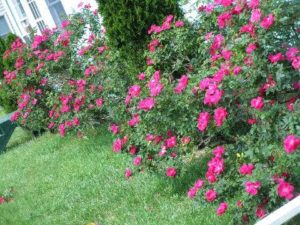
Knock-out roses
— “KNOCK OUT’ ROSES: The “Knock Out” roses are putting on a spectacular display, the best I recall since planting them in my yard in 2008.
— RACCOON/S AT THE BIRD-FEEDER: The battle continues between me and the raccoons at the bird-feeder. I have been putting the feeder in the garage at night, but the raccoon/s sometime beat me to the feeder.
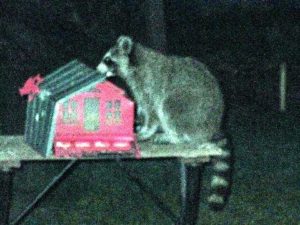
Raccoon at my backyard birdfeeder
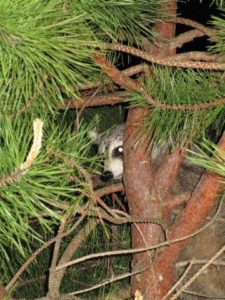
— CANADA GEESE GOSLINGS: Adult Canada geese are out and about with their goslings. The adults are amazing parents — and humans can learn from them, (Photo 6, at Helmetta Pond.)
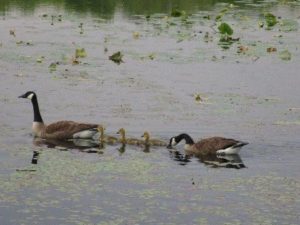
Canada Geese at Helmetta Pond
— NEW JERSEY STATE BIRD AT THE FEEDER: An Eastern goldfinch at one of my bird-feeders. Easily identified as a male because of the bright colors.
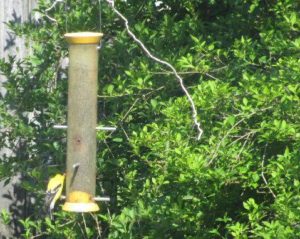
Eastern Goldfinch, the New Jersey state bird
— NORTHERN GRAY TREEFROGS: These called strongly during the week. See http://www.state.nj.us/dep/fgw/ensp/audio/no_gray_frog.wav.
— GARDEN: I planted May 21 and a week later plants were sprouting, most noticeable the Mammoth Gray-Stripe sunflower. Although I do not use fertilizer or pesticides, I water regularly. Once the plants get going, I water before 10 a.m. so as not to lose water to evaporation as the day warms.
— BLACK BEAR MOVEMENT: Reports continue about black bear sightings in Central Jersey and across the Delaware River in Pennsylvania. I am surprised there have not been more reports closer to home. If a bear is sighted, it is likely a 1-1/2-year-old male, perhaps 80 to 100 pounds, looking for its own turf. (What to do when encountering a bear, http://www.state.nj.us/dep/fgw/pdf/bear/bearfacts_know.pdf.)
— YARDWORK: I trimmed the shrubs, then started cutting the grass. I have to finish the lawncutting today. I still have to plant black-eyed Susans.
— BLAST FROM THE PAST, CIRCA LATE 1960S: Paul Migut with an 8-horsepower roto-tiller at his Uncle Stanley “Pon” Ceslowski’s garden on Old Road at Helmetta Road, Monroe. Over the years, Pon, Paul and Jim Becker worked that huge garden.

Paul Migut, circa late 1960s, at Pon’s garden
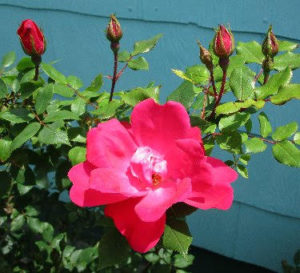
More knock-out roses
Joe Sapia, 59, is a vegetable gardener, who gardens the same backyard plot as did his Italian-American father, Joe Sr., and his Polish grandmother, Annie Poznanski Onda. Both are inspirations for his vegetable gardening. And he draws inspiration on the local Pine Barrens from his mother, Sophie Onda Sapia, who lived her whole life in the local Pines, and his grandmother.
The LRWP has submitted the following letter in response to NOAA’s Invitation to Public Comment on their “Restoration Plan/ Environmental Assessment Draft (RP/EA) for the American Cyanamid Co. Superfund Site, Bridgewater Township, Somerset County, New Jersey”:
May 23, 2016
Carl Alderson
NOAA Restoration Center – Sandy Hook Office
JJ Howard National Marine Fisheries Science Center
74 Magruder Rd, Highlands, NJ 07732
RE: American Cyanamid Draft RP/EA
Dear Mr. Alderson –
The Lower Raritan Watershed Partnership has reviewed NOAA’s proposed Restoration Plan/ Environmental Assessment (RP/EA) for the American Cyanamid Co. Superfund Site, Bridgewater Township, Somerset County, New Jersey and fully supports the proposal for primary and compensatory restoration activities.
The LRWP is New Jersey’s newest watershed association, formed in 2014 to address legacy contamination and current pollution in the Raritan River and the Lower Raritan Watershed. Our mission is to conserve, enhance and restore the natural resources of the New Jersey Watershed Management Area 9, the Lower Raritan Watershed. We believe that not only will removal of the Weston Mill Dam on the Millstone River directly improve resources impacted by legacy contamination, it is our understanding that the proposed project will benefit a broad spectrum of the Raritan River’s ecology and will likewise enable other environmental and human use benefits. Significant ecological, environmental and human use benefits have in fact already been realized following recent removal of a series of dams (Robert Street, Nevius Street and Calco) on the lower portion of the Raritan River between the towns of Bridgewater and Bound Brook. Likewise, we expect that design of technical fish passage at the Island Farm Weir (located on the Raritan River) will advance multiple Lower Raritan Watershed stakeholder goals.
The LRWP is also aware that the removal of the Weston Mill Dam on the Millstone River, as well as future modifications at the Island Farm Weir to include a technical fish passage at the Island Farm Weir on the Raritan River, will expand access to several thousand acres of non-tidal freshwater mid to upper reaches of the Raritan River’s major tributaries. Removal of Weston Mill Dam and the construction of a technical fish passage at Island Farm Weir will significantly enhance maturation and rearing habitat for striped bass, American shad, American eel, blueback herring, and alewife, and should significantly increase the abundance of anadromous and catadromous species, which will improve the ecological health of the Raritan River.
The LRWP’s only concerns with NOAA’s proposal are short term sediment transport impacts following dam removal. However, we are confident that NOAA’s plan to reduce potential environmental consequences is sound and further expect that the proposed projects will provide long term restorative benefits to water chemistry, specifically decreased water temperatures in formerly impounded sections, and increased dissolved oxygen concentrations. These changes will benefit riverine biota from the most basic food chain level up to the top predators for many years to come.
Enhancing fish populations in the Raritan River system is important for fresh and marine ecosystems. It is especially appropriate as the National Marine Fisheries Service (NMFS) lists the estuarine portion of the Raritan River as an important migratory pathway for anadromous alewife and blueback herring, species which NOAA lists as of special concern. The Lower Raritan Watershed Partnership feels that the proposed projects could help to reverse declining population trends, and anadromous fish returning to spawn each spring in the Raritan River provide an attraction to the general public in the Raritan River Basin. The removal of the Weston Mill Dam on the Millstone River and feasibility analysis and design of technical fish passage at the Island Farm Weir are important to the LRWP and we fully support the proposed projects.
Sincerely,
Heather Fenyk, Ph.D., AICP/PP
President, Lower Raritan Watershed Partnership
www.lowerraritanwatershed.org
The National Oceanic and Atmospheric Administration, the Department of Interior, and the State of New Jersey invite public comment on a proposed plan.
The Draft RP/EA is available at the following website:
http://darrp.noaa.gov/hazardous-waste/american-cyanamid
The public comment period on this plan ends June 10, 2016.
To request further information or an additional hard copy of this document or to submit your comments, please contact Carl Alderson at (732)371-0848, NOAA Restoration Center – Sandy Hook Office, JJ Howard National Marine Fisheries Science Center, 74 Magruder Rd, Highlands, NJ 07732 or by email at Carl.Alderson@noaa.gov. Please put “American Cyanamid Draft RP/EA” in the subject line.
Garden and Afield In Helmetta-Monroe-Jamesburg
2016, May 15, Sunday, to May 21, Saturday
by Joseph Sapia

Nearly a Full Corn-Planting Moon during the week
— NIGHT SKY: On Saturday, the moon turned full, the Full Corn-Planting Moon. Look for a bright red Mars for weeks. (The photograph is of the almost-full moon over Monroe and Jamesburg.)
— VEGETABLE GARDENING: I got the vegetable garden in on Saturday, May 21, working in and out of rain. I am a bit concerned I went by the calendar, using May 20 as my guide to when the soil normally would be warm enough to plant, rather than by this year’s still-cool weather. That is, the soil may still be too cool for the warm-season vegetable plants. Perhaps I should have waited to June 1. No matter if I went with my heart over my head, the crop is in: Mammoth Gray-Stripe Sunflower, Cuppa Joe Sweet Corn, Rutgers Tomato, Hale’s Best Jumbo Cantaloupe, Born-to-be-Mild Hybrid Hot Pepper, Kaleidoscope Mix Carrot, Northern X-tra-Sweet Hybrid Sweet Corn, Igloo Lettuce, Carnival Mix Sweet Pepper, and Tasty Green Cucumber.
— OLD SEEDS: The Mammoth Gray-Stripe Sunflower, Cuppa Joe Sweet Corn, and Tasty Green Cucumber are 2015 seeds, which still should produce a crop.
— HOW I SEED: For what it is worth, I do not single-seed. Instead, I place a few to a bunch of seeds per hole.
— POLLINATION IN THE VEGETABLE GARDEN: I am trying something new in the garden, adding flowers to attract pollinators. So, I threw around seeds of Burpee’s Bee and Butterfly Garden and Monmouth Conservation Foundation’s Project Pollinator/Kids for Conservation.
— GARDENING ZONES: As the area transitions from the cooler Zone 6 to the warmer Zone 7, because of global warming, we will have a longer growing season. The gardening downside, more erratic weather. For example, many days of rain, followed by long periods of droughty weather. And, of course, the environmental downside is the global warming.
— RACCOONS AT THE BIRD-FEEDER: I enjoy watching the nightly visit of a raccoon or raccoons at the bird-feeder, sometime joined by a skunk below the feeder. I guess the raccoons and skunk like the sunflower hearts/kernels I use – and they have to eat, too, while entertaining me. But I got tired of the raccoon/s knocking down the feeder night after night. So, for now, I am bringing the feeder inside the garage at night and putting it back out in the morning.
— BIRDS: House finches were flying around the yard, fluttering to trees, bird-feeder, and clothesline, having trouble landing. They must have been fledglings, trying to figure it all out.
— WHIP-POOR-WILL CALLING: About 10:45 to 11 p.m. Wednesday night, May 18, a whip-poor-will called loudly, if only sporadically. This was once a common bird here in the local Pine Barrens – calling ad nauseam through the overnight. But this one was the first I have heard in an estimated 6 years. I got reports of whip-poor-will calls from around my Helmetta Road neighborhood, so I hoping for a return of the whip-poor-will.
— MOUNTAIN LAURELS AND SNAPPING TURTLES: Mountain laurel should begin blooming about now. So, remember this bit of Pine Barrens lore: “The snapping turtle lays its eggs, when the mountain laurel blooms.” Watch for snappers crossing roads – probably a female headed to high ground from a swamp to lay eggs or a female returning to a swamp after laying her eggs on high ground. If helping the turtle along, move it in the direction it is traveling. I MOVE A SNAPPER ONLY WITH A SHOVEL, because here is more Piney lore to think about, “Only the setting sun or lightning makes the snapping turtle let go.” If bitten, try running a wire down its nostril to make it let go. (Moving a snapper by lifting it by its tail could hurt it – and, also, it could bite the mover and not let go….)
(Garden observations are from my yard in the Helmetta Road area. Pine Barrens observations are from the Helmetta-Monroe area Pines.)
Joe Sapia, 59, is a vegetable gardener, who gardens the same backyard plot as did his Italian-American father, Joe Sr., and his Polish grandmother, Annie Poznanski Onda. Both are inspirations for his vegetable gardening. And he draws inspiration on the local Pine Barrens from his mother, Sophie Onda Sapia, who lived her whole life in the local Pines, and his grandmother.
Article and photos by Joe Mish

This female red phase screech owl with erect ear tufts and large eyes looks as ferocious as it sometimes sounds.
The calm starlit night, made blacker by the dark phase of the moon, was the perfect setting for a peaceful night’s sleep. The windows were wide open and the air scented with honeysuckle as the gentle sounds of the night played a sleepy time lullaby.
Deep sleep and dreams were well under way when a primal scream, just outside the window, vibrated the walls. Everyone sat up, hearts beating wildly, sleeping coonhounds unleashing unheard of sounds that must have been reserved in the event they ever treed the devil.
Before my heart beat slowed, I figured the sounds had to come from a screech owl perched on a tree limb six feet from the bedroom window. The unearthly screams were one selection of screech owl vocalizations that include rapid clicking of its beak and a gentle wavering call that, through association with spooky movies can easily raise the hairs on the back of your neck.
The volume of a screech owls’ motivated scream is inconsistent with its small size. The eastern screech owl is about 9 inches tall, weighs around 6 ounces with a 24 inch wingspan and easily fits through a three inch nest box hole.
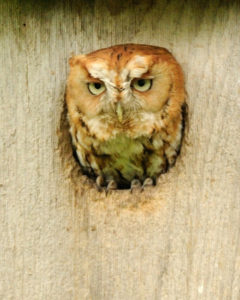
Adult red phase screech owl perches in 3″ hole of its nest box, note the feet gripping the edge of the opening.
Eastern screech owls come in two colors, a red phase and a gray phase. Its physical appearance, while perched, gives the impression it is missing the lower half of its body. During the day with its eyes shut it blends in so perfectly with its background it is difficult to tell what part is what. The owl seems to suddenly appear from the background when it opens its large yellow eyes.
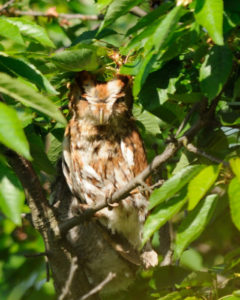
Eyes closed, these owls seems to disappear with no reference to top or bottom or recognizable form.
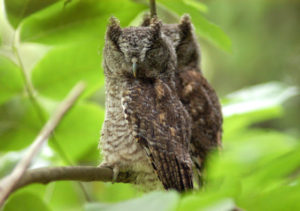
Screech owls seem to comfortably tolerate humans and can be seen, and will nest, in proximity to homes and buildings if a nest box is provided.
Late June early July, a screech owl would show up whenever I went into the backyard around dusk. It would follow me around and click its beak from a nearby branch. I have no idea what motivated that behavior but that owl provide plenty of photo opportunities.
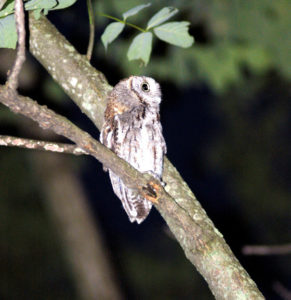
Then there were the memorable Christmas day visits. One Christmas morning I went to the open woodshed to replenish the woodstove with an armful of oak. There, staring me in the face from four feet away was a gray phase screech owl. It stayed put while I gathered the wood but was gone when I returned with my camera.
A few years later on Christmas night, a red phase screech owl perched a few feet off the ground in a weeping cherry tree. The little owl was spotted by the car’s headlights. It remained undisturbed while I did capture its image.
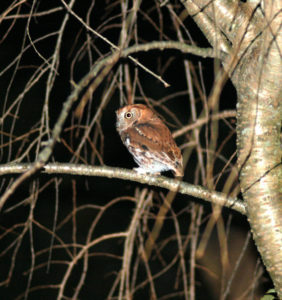
A late Christmas present in full feather, delivered at the front door.
Screech owls may just as well be found in deep woods. I have a great image of a red phase owl sitting in a healed hole in the side of a large tree trunk about eight feet off the ground. Other sightings have been in places where mature sycamore trees grow. Often, broken branches will leave a cavity that overtime becomes deeper, forming a perfect nest or day time resting place for this diminutive owl.
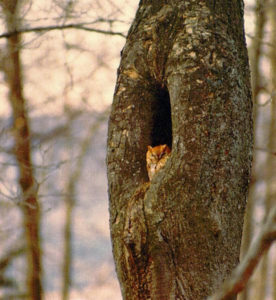
Though screech owls are quite common, you may never see one. Think of them as a night time radio host whose show you listen to all the time but never put a face to the voice. Hear a sampling of screech owl calls at: https://www.allaboutbirds.org/guide/Eastern_Screech-Owl/sounds
Author Joe Mish has been running wild in New Jersey since childhood when he found ways to escape his mother’s watchful eyes. He continues to trek the swamps, rivers and thickets seeking to share, with the residents and visitors, all of the state’s natural beauty hidden within full view. To read more of his writing and view more of his gorgeous photographs visit Winter Bear Rising, his wordpress blog. Joe’s series “Nature on the Raritan, Hidden in Plain View” runs monthly as part of the LRWP “Voices of the Watershed” series. Writing and photos used with permission from the author.
Our friend and “Voices of the Watershed: Pinelands of Helmetta” contributor Joe Sapia writes:
“Wow, I just heard a whip-poor-will calling at my house in the Helmetta Road area. That is the first time in about 6 years I have heard this bird, once a harbinger of spring in the local Pine Barrens, since about 2010.
Antrostomus vociferus is considered a jeopardized species in NJ. This one, I heard from about 10:45 p.m. to 11 p.m. Its call was powerful, meaning it was close, but it was sporadic, not the ad nauseam call.
Listen to an example and multiply that all night.
Around here, I would say this bird is a Pine Barrens bird, so it could be heard in parts of Monroe (north of Jamesburg and hugging the Old Bridge and Manalapan boundaries), anywhere in Helmetta and Spotswood, and other local Pine Barrens areas.
If you hear one locally, let me know when and the general location. Thanks.
A few weeks ago, I saw a brown thrasher, “Toxostoma rufum,” the first one I saw locally in years. What is going on?”
Received today from Carl Alderson, NOAA Federal
To All Interested Government Agencies and Public Groups:
Under the National Environmental Policy Act, an environmental review has been performed on the following action.
TITLE: Restoration Plan/ Environmental Assessment Draft (RP/EA) for the American Cyanamid Co. Superfund Site, Bridgewater Township, Somerset County, New Jersey
LOCATION: The Millstone and Raritan Rivers, Somerset and Middlesex Counties, New Jersey.
SUMMARY: The National Oceanic and Atmospheric Administration (NOAA) is the lead federal agency for National Environmental Policy Act (NEPA) compliance for projects brought forth to restore injured habitat for fish and other trust resources resulting from long-term hazardous substance releases from the American Cyanamid Co. Superfund Site in Bridgewater Township, New Jersey. Projects identified in the RP/EA are compensatory for lost resources and fulfill an obligation to serve the public as required under the Comprehensive Environmental Response, Compensation, and Liability Act of 1980 (CERCLA), also known as Superfund Law. Superfund is a United States federal law designed to clean up sites contaminated with hazardous substances and pollutants. The Draft RP/EA proposes removal of the Weston Mill Dam on the Millstone River as well as feasibility analysis and design of technical fish passage at the Island Farm Weir, located on the Raritan River.
As documented in the RP/EA, the selected projects are expected to have an overall beneficial impact on ecosystem function and species biodiversity. The project’s goals include benefits to various species, improvement of habitat function, and protection of existing habitat. Because the project is intended to restore natural resources, it is expected to cause a net increase to habitat productivity and improve ecosystem function.
INVITATION TO PUBLIC COMMENT: The National Oceanic and Atmospheric
Administration, the Department of Interior, and the State of New Jersey invite public comment on a proposed plan.
The Draft RP/EA is available at the following website: https://darrp.noaa.gov/hazardous-waste/american-cyanamid
The public comment period on this plan ends June 10, 2016.
One hard copy of the RP/EA will be available in each of the following public library locations:
Manville Public Library
Address: 100 S 10th Ave, Manville, NJ 08835
Phone: (908) 722-9722
Hours: Mon-Thurs 9:30AM–9PM
Friday-Sat 9:30AM–5PM
Franklin Township Public Library
Address: 485 Demott Ln, Franklin Township, NJ 08873
Phone: (732) 873-8700
Hours: Mon-Thurs 10AM–9PM
Fri-Sat 10AM–5PM
To request further information or an additional hard copy of this document or to submit your comments, please contact Carl Alderson at (732)371-0848, NOAA Restoration Center – Sandy Hook Office, JJ Howard National Marine Fisheries Science Center, 74 Magruder Rd, Highlands, NJ 07732 or by email at Carl.Alderson@noaa.gov. Please put “American Cyanamid Draft RP/EA” in the subject line.
From: www.nj.com “Community Bulletin”
The Somerset County Regional Center Partnership, utilizing a grant from the New Jersey Water Supply Authority (NJWSA), has announced that the 2016 Raritan River Rain Barrel Rebate Program for homeowners in Bridgewater, Raritan, and Somerville is accepting applications for the sixth year of the program.
The Rebate Program in intended to encourage residents to purchase and install rain barrels by offering rebates up to $200. Rebates are available in the amount of $50 for rain barrels that hold 40 to 70 gallons and $100 for those that hold more than 70 gallons. Rebates are available for multiple rain barrels that meet all criteria.
Residential homeowners within the Peters Brook Watershed who purchased and installed rain barrels after July 1, 2011 remain eligible for a rebate providing documentation is available. Residents outside the Watershed but within the boundaries of the three municipalities must have purchased the rain barrel after January 1, 2014. Sufficient documentation including proof of purchase and installation is required.
Rain barrels provide homeowners with financial and ecological advantages by conserving water, easing stream erosion by reducing the volume of runoff entering to streams and rivers during storms, and reducing pollutants accumulated from impervious surfaces, particularly roofs. In established urban areas like the Regional Center, rainwater runoff from hard surfaces flows directly into streams, depositing these pollutants.
Rain barrels must have a closed design or screen top; have a system to direct excess water away from the home’s foundation; have a spigot not higher that 3″ from the bottom of the barrel; and must be made of a sturdy material and installed on a solid level base. Homeowners must pledge to maintain the rain barrel for at least two years to be eligible for the rebate.
“A rain barrel is a simple and effective way of practicing environmental responsibility,” commented Troy Fischer, Chair of the Somerset County Regional Center Partnership. “Homeowners in the Regional Center communities have a unique opportunity to recoup their investment twice, once through the rebate and multiple times through re-use of rain water.”
Rebates will be awarded on a first come, first served basis, and funding is limited. Detailed information can be found on the Regional Center Partnership’s website at www.regionalcenterpartnership.org, by calling 908-730-0270 x223 or sending an email to rainbarrel@raritanbasin.org.
The Somerset County Park Commission is supporting the 2016 Rebate Program by including information on the web site, www.somersetcountyparks.org, and in kiosks and at special events throughout the County park system.
Article and photos by Joe Mish
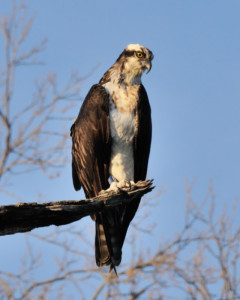
The osprey from Maine searches the clear water of the South Branch for a meal as she takes a break from her 2,500 mile journey north. The letters, DV, can be seen on the blue band attached to her right leg.
The warmth from the mid-morning sun felt good on my back as I paddled the low, clear water of the South Branch. The cloudless sky, directly above, was a darker shade of blue, its intensity pure and endless, and mesmerizing. It compelled me, as the devil’s advocate, to search for just a single speck to interrupt its perfection.
Suddenly a shadow sped across the water, momentarily stealing the sunlight. I instinctively looked up to catch a glimpse of an osprey circling above. The white head, streaked with a dark brown stripe, was instantly recognizable. The osprey proceeded downriver by making tight overlapping circles in its search for fish. It isn’t too hard to imagine some of these super intelligent predators realize a canoe is herding the fish ahead of it. When the osprey was about 150 yards downstream it tucked its wings and dove into foot deep water to come up with a large white sucker held fast in its black talons. The bird oriented the position of the fish to cut wind resistance as it flew out of sight.
Ospreys are ever present on the South Branch, typically from early spring to mid autumn. They feed primarily on live fish. I see them most often eating white suckers, a fish large enough to compensate for the energy spent to catch it.
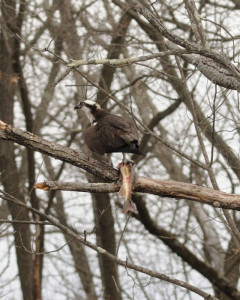
Osprey on a riverside perch, dining on fresh fish during the 2014 NJ opening day of trout season.
Earlier this April, I noticed an osprey perched in the same location day after day. This wasn’t typical of the local ospreys that ranged far and wide in their constant search for food. I was able to get a few photos and noticed a blue band on the right leg and a silver band on the left. I reported the band to the USGS website, BandReports@usgs.gov, to find this osprey was banded in Portland, Maine, July 27th, 2011 while it was still in the nest, too young to fly.
Osprey migrate from the northeast, where they breed, to central and South America each fall, a trip of more than 2,500 miles. This bird was apparently on its way back to Maine and stopped to rest. Osprey, like other migratory birds, are very loyal to nest sites and return to the same location with great predictability.
Consider our visiting osprey will be 5 years old this July, and has 25,000 plus, frequent flyer miles on its account, you have to recoil in amazement, wonder and respect for its strength and tenacity. As osprey can live 25 to 30 years or more, the mileage really adds up.
Our Maine visitor, a female, as evidenced by her speckled décolletage, has a bright and long future and hopefully will stop along the South Branch again on her journey to and from Central America. No doubt other osprey are flying to northern breeding grounds through NJ, so the opportunity to spot a banded bird along the North and South Branch are quite good.
The reporting of banded birds is critical to wildlife research as it helps to unravel the mystery of migration, the location of breeding grounds, longevity, and other variables that impact the health and status of local and overall wildlife populations.
New Jersey is now using red bands for osprey and from Ben Wurst at conservewildlifenj.org, as per USGS; “Green anodized bands are being used in NY. Purple anodized bands in MD and VA. Red anodized bands (like ours, but with alpha code A&B 00-99) in PA (permit is expired now). Blue anodized bands in MA, ME & Ontario.”
The preponderance of osprey nests in NJ are along the Delaware River and Atlantic shoreline, its estuaries, bays and rivers, so keep an eye out for banded birds and report them to BandReports@usgs.gov . The researchers are as excited about a band report as you and will send a certificate of appreciation with relevant data about your bird. Many species of birds are banded, so don’t forget our eagles, hawks and songbirds. Opportunities abound as NJ is on a major flyway, the rivers being main exit and entrance ramps to our backyard.
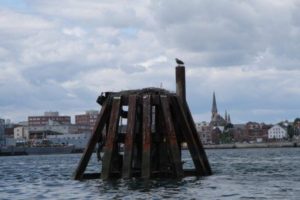
*Joe sent us an update to this post, a photo of the exact location in Maine where the osprey was born. Photo courtesy of Lauren Gilpatrick at the Biodiversity Research Institute, Portland Maine.
See, http://www.conservewildlifenj.org/education/ospreycam/ for more details about NJ osprey project and live osprey cam.
Special thanks to Robert Somes, Kathy Clark and Ben Wurst for their enthusiastic help and support.
Robert Somes, Senior Zoologist
NJ Division of Fish and Wildlife
Endangered and Nongame Species Program
Kathy Clark,CWB,
NJ Division of Fish and Wildlife
Endangered and Nongame Species Program,
Ben Wurst, Habitat Program Manager
New Jersey Osprey Project
Author Joe Mish has been running wild in New Jersey since childhood when he found ways to escape his mother’s watchful eyes. He continues to trek the swamps, rivers and thickets seeking to share, with the residents and visitors, all of the state’s natural beauty hidden within full view. To read more of his writing and view more of his gorgeous photographs visit Winter Bear Rising, his wordpress blog. Joe’s series “Nature on the Raritan, Hidden in Plain View” runs monthly as part of the LRWP “Voices of the Watershed” series. Writing and photos used with permission from the author.
By: Heather Fenyk
Part of the fun of reading comic books when I was a kid was coming across ads for the absurd: Monster Size Monsters! X-Ray Vision Glasses! Kung-fu Sandals! (AUTHENTIC! Worn for Centuries by Oriental Fighting Masters!) But my absolute favorite adverts included invitations to “Own A Bowl Full of Happiness.” For just 49¢ plus $2.99 shipping, you could raise your own “trainable” insta-pet, the Sea Monkey.

Sea-Monkey ad from 1970’s comic book
Sea Monkeys fall into a general group of organisms including brine shrimp and “fairy shrimp” that, with the proper mix of nutrients and chemicals, can be stored in dry form and then “revived” with a dose of plain tap water.
Recent rains have nourished our New Jersey swamps and freshwater marshes, transforming seeming terra firma into vernal or ephemeral ponds. These ponds – or more specifically their “fairy shrimp” inhabitants – get me out in the field looking for Sea Monkeys.
The descriptive terms for these freshwater wetland types — “vernal” and “ephemeral” — refers to their habit of appearing in spring and being short-lived or temporary. Many vernal ponds in New Jersey and elsewhere were not protected during the post-World War II building boom. But with the passage of the New Jersey Freshwater Wetlands Protection Action in 1987, all freshwater wetlands – including these temporary wetlands – were finally granted protection. Fairy shrimp benefit directly from these protection measures.
A common species of fairy shrimp in our New Jersey vernal ponds is Eubranchipus vernalis. It grows between 0.5 and 1.5 inches in length, and other than its forked tail and large, stalked, compound eyes, its most obvious features are the 11 pairs of feathery appendages it uses for swimming, breathing and feeding. It collects algae, bacteria, protozoa, rotifers, and detritus on the feather-like structures and transfers that material to its mouth by other appendages. In addition, it will scavenge dead tadpoles, mollusks and amphibian eggs.
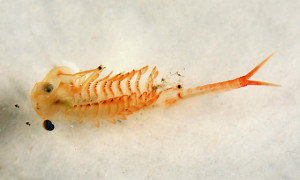
Eubranchipus vernalis. Image from www.bugguide.net
The shrimp’s reproductive strategy is fascinating. After mating, the male dies. The females are easily distinguished from males by the egg-filled brood sac on their abdomen, and the sac contains one of two types of fertilized eggs depending on the density of males in the pond. A low density of males results in thin-shelled “summer eggs,” which have a very short incubation period and hatch inside the brood sac. A high density of males results in thick-shelled “winter eggs” that eventually fall to the bottom of the pond and remain there even when the pond dries out. They will hatch the following spring, when the pond refills, and they have an amazing capacity to withstand extreme elements, including temperatures that are probably never encountered in nature: from a high of just below boiling (210 degrees) to a low extreme of -310 degrees.
The powdered thick-walled eggs of fairy shrimp are the type that my sister Julie purchased in 1978 from the back of an Archie Comic Book. It is this egg stage that enables the fairy shrimp to be distributed to other potential vernal ponds. Fairy shrimp eggs are tiny, dry granules that can be blown by the wind or picked up on the feet of animals and carried to other vernal ponds. These thick-walled, dry eggs remain viable even after 15 years, and the eggs are supposed to hatch 30 hours after being submerged in water.
Sadly, Julie’s order of Sea Monkeys never hatched. While she was perhaps permanently scarred by being duped into purchasing a package of powdered brine shrimp, I remain suckered in by the advertising and happily spend spring weekends exploring New Jersey’s vernal pools looking for my own Sea Monkeys to train.
Happy National Sea Monkey Day!
Article and photos by Joe Mish
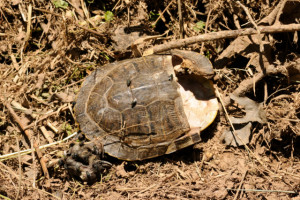
A slow journey that began more than a million years before, ended at the tip of a mower blade spinning at 3,200 rpm. This wood turtle, listed as ‘threatened’ in New Jersey, was killed in late May, while on its way to lay eggs.
May and June have been the peak of the great turtle migration where females, laden with eggs, leave the protection of quiet places to journey far and wide to dig holes and bury their eggs. Incubation takes about 70 days, more or less, and nests are left unattended.
All species, whether aquatic, terrestrial or both, like the wood turtle, seek dry land to lay eggs. Each has a preference for where and when they dig nests, though individual variation is the rule.
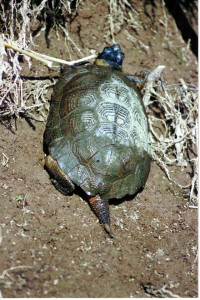
A wood turtle on its way out of the river where it hibernated to lay eggs in the gravel soil near railroad tracks.
Wood turtles prefer gravel laden soil on high ground, as found along railroad tracks, roadsides and driveways.
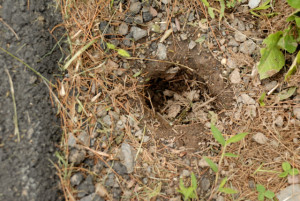
Roadways have become the killing fields for these slow moving reptiles where large blocks of undisturbed habitat are segmented by roads. A preserved island of land may be celebrated as a conservation success but the lack of linear greenways to bridge these islands is a death knell for many small creatures as it exposes them to predation and roadkill.
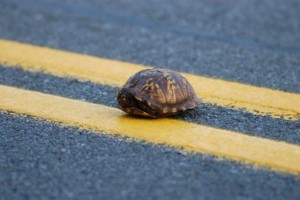
Eastern box turtle pauses mid journey across a New Jersey roadway, in a false retreat that offers no protection form speeding vehicles.
Turtles are creatures of habit and maintain consistent pathways from year to year. So that eastern box turtle you saw crossing over the double yellow line last year will be crossing the road in the same place this nesting season.
Mowing tall grass during nesting season is a more insidious cause of death for turtles and grassland nesting birds. Many farmers and landowners alter their mowing schedule to prevent killing fawns and game birds; turtles and grassland nesting birds are coincidental beneficiaries.
State conservation organizations advocate mowing early in the season and then not again until August, late July at the earliest.
A driver may possibly avoid killing a turtle on a paved road as it is somewhat visible, while a turtle in tall grass is a foregone conclusion when a mower runs through a field. The fractured shell of the wood turtle pictured, was found on a path mowed through an overgrown pasture near the South Branch.
Females may travel half a mile from wet areas to lay eggs, so please be careful. As the wood turtle is considered, “threatened “, and known to populate our area, special caution should be taken. May 29, 2015, a female wood turtle was observed digging a nest within inches of a long paved private drive, in hard packed gravel. This would be the last place you’d ever expect a turtle to dig, as you would be hard pressed with a pick and shovel to penetrate that ground. The hole was about 5 inches deep and 4 inches wide.
An awareness of turtles and their nest sites are a prerequisite to protecting them. As the eggs are laid in a small hole, covered and left unattended, you’d never know you were endangering a nest. Many eggs don’t hatch or are destroyed by predators. Then imagine an inch long hatchling trying to traverse a quarter mile through fields and open ground in an effort to reach water, bog or swamp. Survivors are few and far between.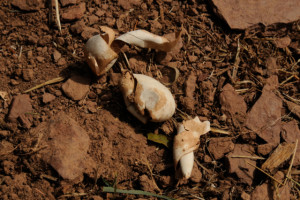
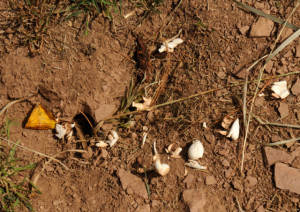
…you will find collapsed leathery egg shells scattered about; though they won’t look like egg shells. Imagine an egg shell make of cloth and inwardly collapsed to appear as a scrap of white material.
With poor odds for survival, it begs at least awareness on our part to, “first, do no harm”, and avoid destroying nests or mulching hatchlings and adults with a mower.
Turtles remain in their essential form that traces back to prehistoric times. Their evolution is an unrivaled success, even more astounding when their slow lumbering movements and low reproduction rate are considered.
Some interesting anatomical features reveal the secrets hidden behind the shell. See how the spinal cord is integral to the carapace or top shell in this painted turtle. The box turtle shell shows the spine as well as the clavicle. The thin plates that line the outer surface of the shell are attached much like a fingernail.
The easiest way to find a turtle nest is to look for the open holes in late summer and early fall. Either the nests were naturally opened by emerging turtlettes or dug out by raiding predators. In either case you will find collapsed leathery egg shells scattered about; though they won’t look like egg shells. Imagine an egg shell make of cloth and inwardly collapsed to appear as a scrap of white material. Last year I found 6 nests, one, just outside my back door. I had never seen a nest before but once I knew what to look for, they seemed to be everywhere.
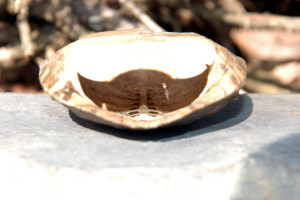
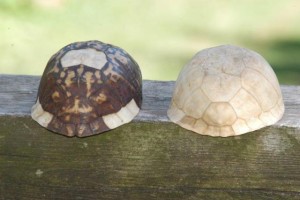
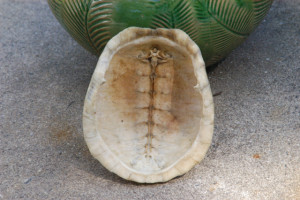
The Unami, one of the three matrilineal clans of the Lenape indians, who lived in central New Jersey, were known as the Turtle Clan. Treating the turtle with respect, keeps the clan of the turtle alive and well in the land it has known since the last glaciers receded and the land emerged from the sea. Consider, the turtle had arrived at it final evolutionary form long before humans. As new to the neighborhood, we might look to the turtle for guidance as we would a centenarian, to seek advice on how to live a long life in alignment and peace with our ever changing environment.
Author Joe Mish has been running wild in New Jersey since childhood when he found ways to escape his mother’s watchful eyes. He continues to trek the swamps, rivers and thickets seeking to share, with the residents and visitors, all of the state’s natural beauty hidden within full view. To read more of his writing and view more of his gorgeous photographs visit Winter Bear Rising, hiswordpress blog. Writing and photos used with permission from the author.





























